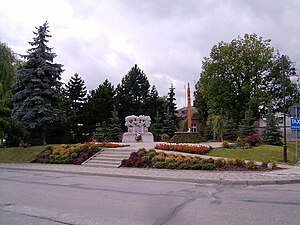 |
| English: Jarosław, Bożnic square, polish - hungarian friendship monumnet and Leon Czechowski Monument Polski: Jarosław, plac Bożnic, pomnik przyjaźni polsko - węgierskiej i kopijnik upamiętniający Leona Czechowskiego (Photo credit: Wikipedia) |
On March 23 of every
year, two European countries celebrate their good relations- Poland and Hungary.
The holiday came to be known as Polish-Hungarian Friendship Day

How did these close relations start? Back in the Middle
Ages, intermarrying amongst Hungarian
and Polish nobles was commonplace. In fact, at separate times the same man,
Louis the Great, was King of Hungary and King of Poland. Władysław III
similarly served as both King of Poland and King of Hungary at separate times. The
two nations assisted each other in various battles throughout their history- a
Polish legion of 1,200 Polish soldiers came to aid Hungary in the Hungarian
Revolution of 1848. Hungary offered to send 30,000 cavalry to help Poland
during the Polish-Soviet war, and many munitions trains reached Poland despite
Czechoslovakia’s refusal to allow Hungarians through the demilitarized zone.
During World War II, Hungarian Admiral Horthy of the Axis
Powers refused to send troops to help invade Poland faster, stating that he did
not wish to dishonor Poland and Hungary’s friendship. Because of this refusal,
many Polish government officials and military men were able to escape Poland
into neighboring Hungary. The Polish October revolution for reform helped spur
the Hungarian Revolution of 1956, and over 11,000 Poles showed their support by
donating blood to Hungarians.
And in 2007, just 11 day before the soon-to-be Friendship
Day, the Hungarian parliament unanimously declared March 23rd “Polish-Hungarian
Friendship Day” with all 324 votes in favor. Four days later, an election in
the Polish parliament also declared the new holiday.
And how is this day celebrated? Despite its official date,
festivities run for over a week, and involve the Presidents and government
representatives from both countries coming together. Just some of the events
include “theatrical performances, films, exhibitions, concerts, workshops,
[and] scientific exhibitions.”

A proverb exists about these two countries together- “Pole
and Hungarian cousins be,” or “Pole and Hungarian, two good friends.” And
another 1849 quote by a Polish activist, Stanlislaw Worcell, similarly embodies
the good relations: "Hungary and Poland are two eternal oaks. Each of them
shot up a separate and distinct trunk, but their roots widely scattered in the
ground are intertwined and knitted invisibly. Hence the existence and vigor of
one is the condition of the other's life and health."
Sources: Wikipedia, Polish Greatness.blogspot, Poznan.pl, The News.pl

Happy friendship day to u .. its a nice article on for sending friendship day greetings also check : Friendship day SMS Messages in Malayalam
ReplyDeletelabor thanksgiving day food
ReplyDeletehow does japan celebrate thanksgiving
japanese thanksgiving food
japanese thanksgiving traditions
japanese holidays
japan during thanksgiving
marine day
greenery day
Thanksgiving Day in japan